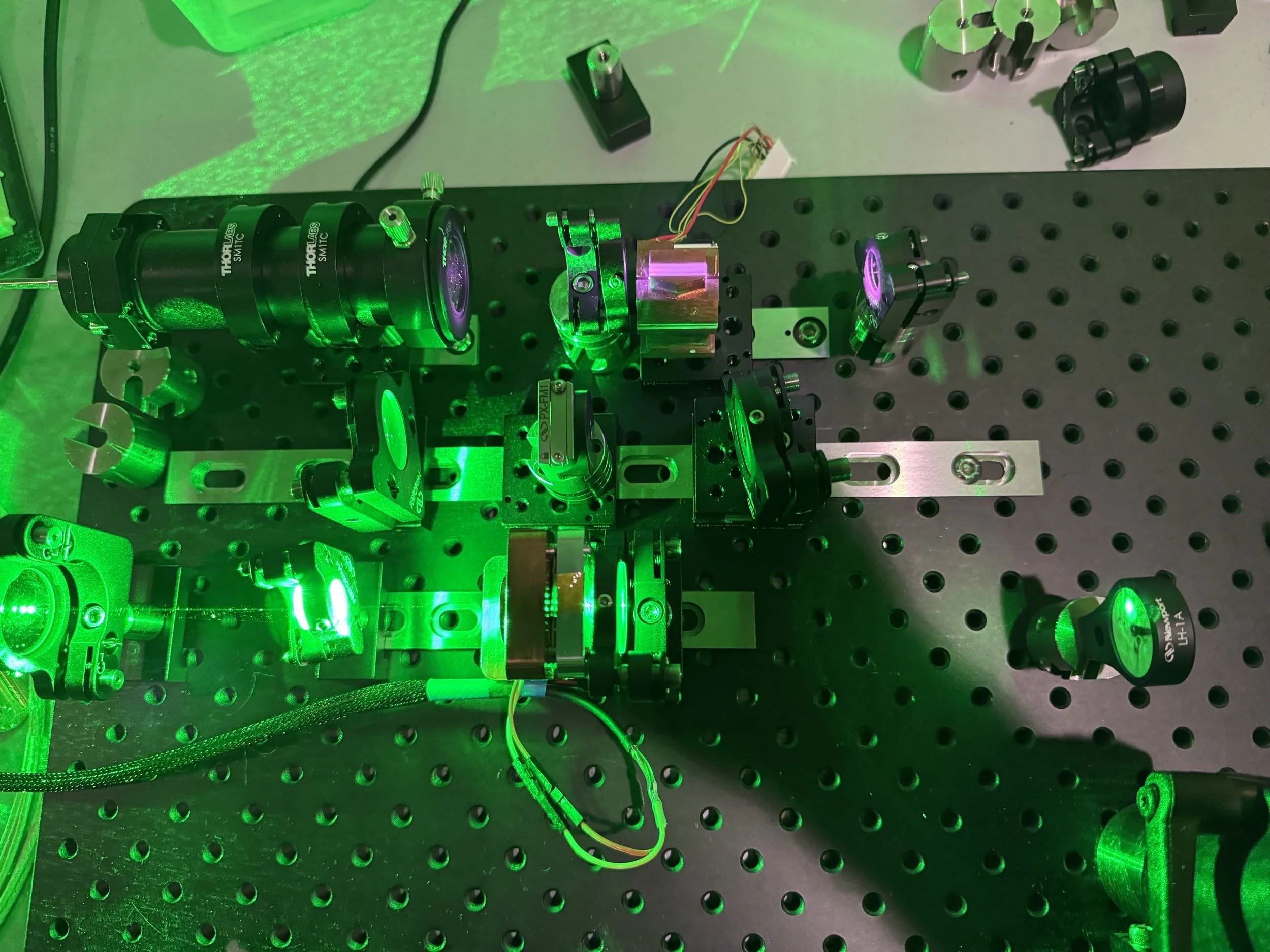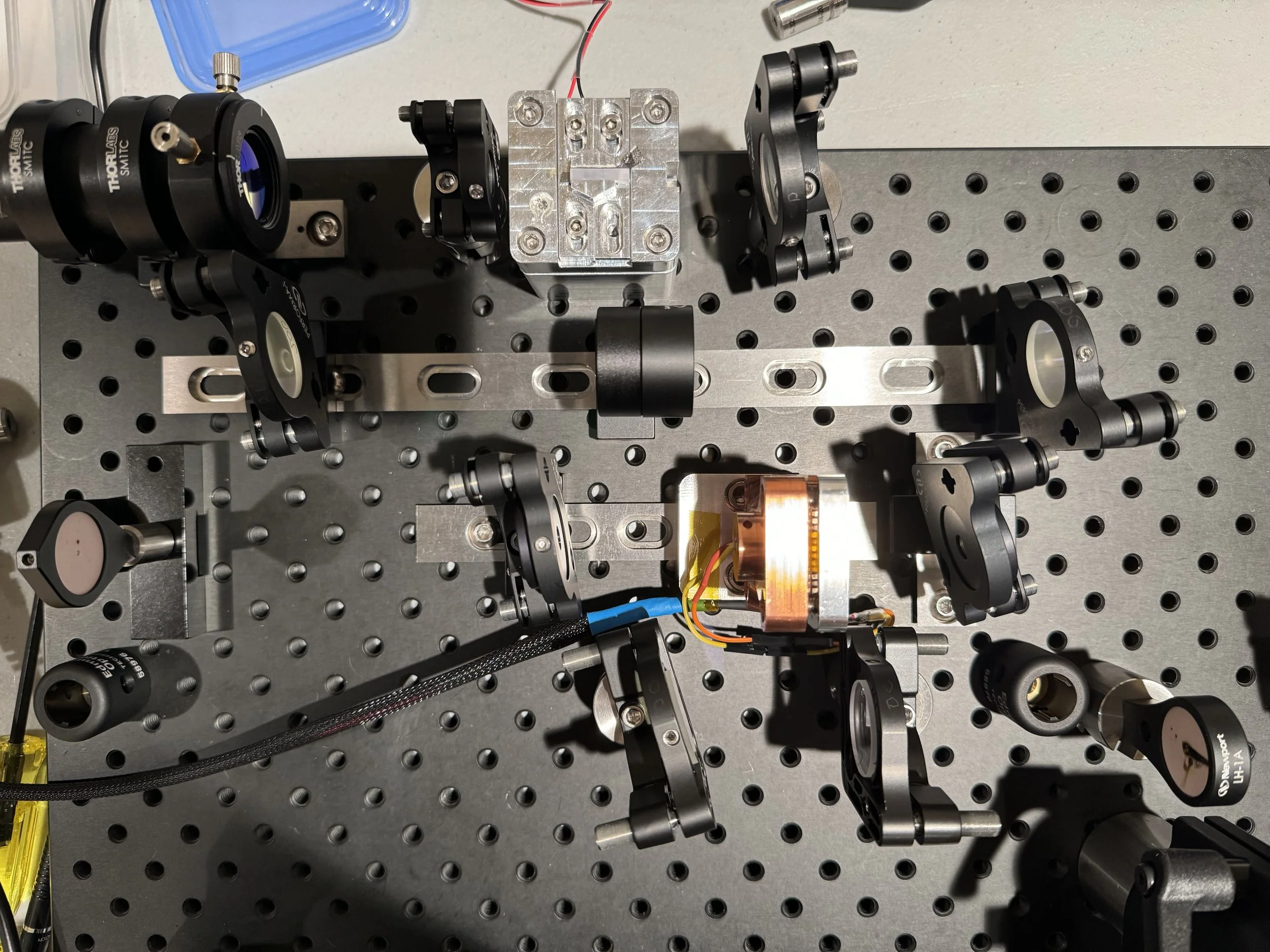You know it’s a bad sign when my “hobby project” has quarterly updates….and has now been going for five years. But I learn a little each day. Let’s recap some of my recent knowledge.
I haven’t been spending as much time on the Laser Project as I once did. Life, it turns out, often has other priorities. Still, I’ve furthered my understanding a bit.
A quick update and demonstration of how critical keeping the KTP a constant temperature is.
In my last post I voiced some doubt my thermal lensing calculations are accurate. Accuracy here is pretty important because I’m planning on using the lensing effect to improve second harmonic generation. This post is the result of some of my testing.
Second Harmonic Performance
This graph shows the measured and calculated second harmonic performance from a test laser. You’ll note the calculated data doesn’t match very well with measured values. Here I’m showing two types of calculations. The blue line includes calculations for thermal lensing while the green line ignores it.
So what’s going on? There are two possibilities here:
Thermal Lensing calculations are wrong.
SHG calculations are wrong.
Q-Switched Infrared Measurements
To try to understand this better I started by converting this laser back to infrared. Second harmonic conversion has some very complicated physics that make the laser behavior very non-linear. Infrared is much simpler. In the above graph, there is a big difference in behavior between the green and blue curves. Here are the same curves for an IR laser:
This graph shows the calculated vs measured IR laser power:
From here we can deduce that the calculations for laser output power are pretty close to reality, even for Q-switched operation. But we are no closer to understanding if the problem lies in thermal calculations or second harmonic calculations.
An idea I had to resolve this was to look at the repetition rate of the Q-switch pulses. This laser is using a saturable absorber for Q-switching and if the beam waist changes in the absorber it will change the speed at which the absorber saturates. This laser cavity design has a “trough” where the beam waist sharply narrows. Depending on where the saturable absorber is placed you can adjust the waist in the absorber. But more importantly, this trough shifts to the left with thermal lensing. So if you place the absorber to the left of the trough, the beam waist in the absorber narrows with thermal lensing. If you place the absorber to the right of the trough, the beam waist increases with lensing. We can record the pulse repetition rate for both cases and compare the measured values to calculations.
Placing the absorber to the left of the trough:
And the right of the trough:
Now the calculated repetition rate here is a little off from measurements, but the important thing here its the trend line. It’s very apparent in the second graph that we are seeing thermal lensing change the behavior of the laser, and that the calculations do predict the measurements.
Conclusion
If we look back to the original second harmonic graph we see that about 27 amps of drive current we predict laser destabilization due to thermal lensing. But looking at the measured graph this looks like the point where the laser begins to destabilize. The laser doesn’t suddenly stop working: its performance just degrades.
The thermal lensing calculations do seem to be predicting the laser behavior. The difference in calculated and measured performance must be due to the second harmonic calculations. This is not that surprising: even in graduate laser texts the measured second harmonic performance is worse than the predicted results. The reason cited for this is the difficulty in getting perfect phase matching.
Taking these into consideration here are may take-aways:
We should assume the predicted maximum thermal lensing drive current is accurate and not expect laser performance beyond this point.
We should expect the second harmonic conversion rate to be significantly worse than predicted. I can fudge these numbers by introducing some phase mismatch fudge factors, but it is better to keep the ideal values and work to minimize the phase mismatch in the actual laser.
Going Forward
The result of this is that it’s a lot harder to get significant power out than the math first predicts. A key metric is how much thermal lensing the cavity can tolerate. I am trying a new test cavity that uses much larger mirror curvatures. This cavity does get to a 5x mode radius compression into the KTP, but cannot get a 20x compression into the Cr:YAG. The larger curvature allows the cavity to handle very large thermal lensing levels and the math predicts very similar performance with lensing to that without. The downside of this new cavity is some of the lengths are very long — it is hard to build it on the optical breadboard I have.
I have also changed my technique to aligning laser cavities. The number of mirrors combined with optics that are AR coated for 532nm means aligning with a green laser is not possible. I’ve purchased a low power 1064nm laser, which reflects perfectly off the mirrors for this laser. I do have to replace the first HR with an 80/20 output coupler so I can get the beam properly aligned through the cavity, and I have to do all alignment using an IR camera which is kind of a pain. But while more time consuming it yields better success than using the green laser for alignment.
So I built a laser last year. It worked but didn’t perform great. Let’s find out why.
I’m going to start digging more in to the physics part of my laser project and for this I will want to be able to render some math.












